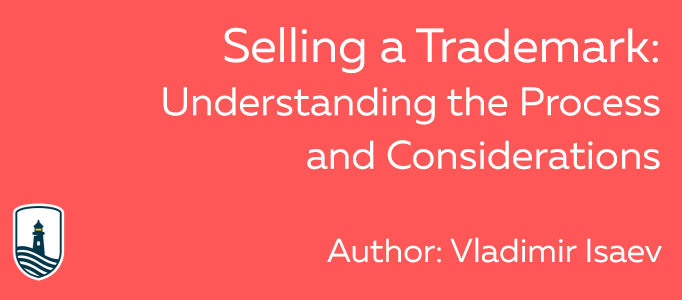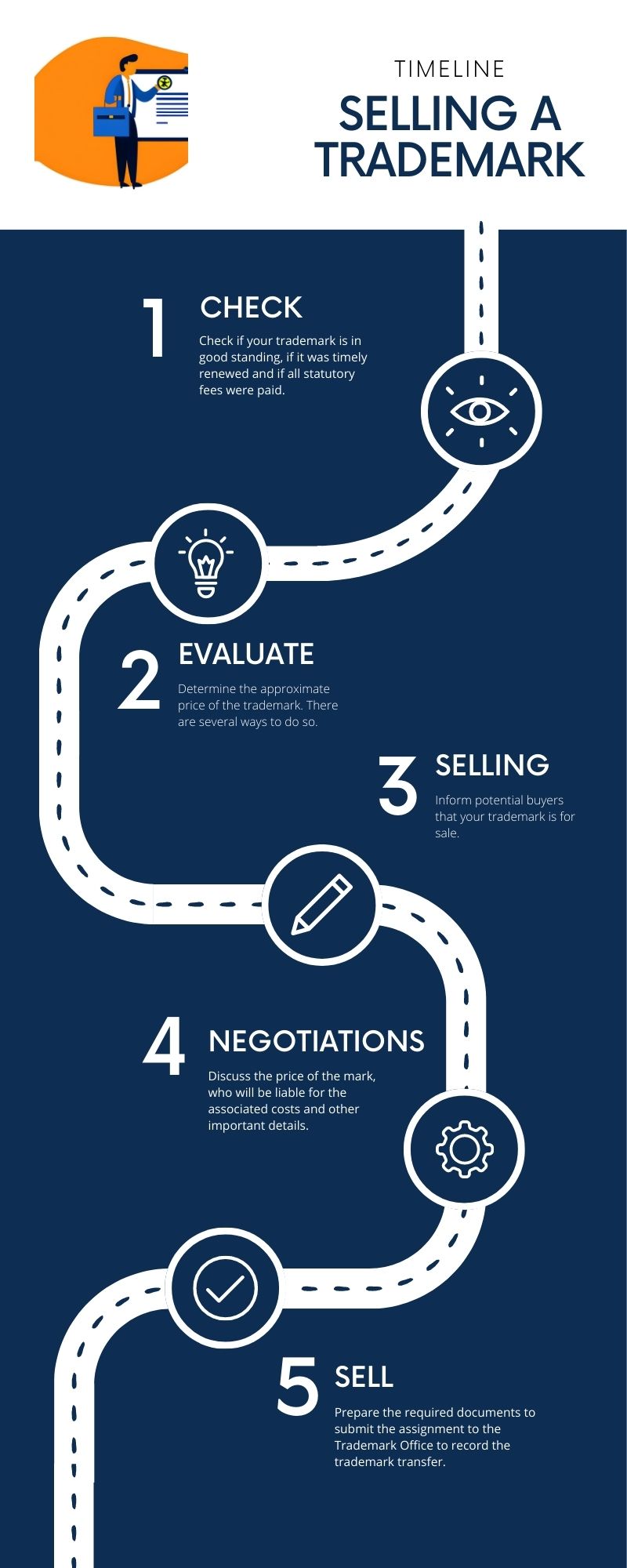Selling a Trademark: Understanding the Process and Considerations

When it comes to establishing a business, one aspect that holds significant value is the trademark associated with it. A trademark serves as the face of a brand and helps in distinguishing products or services from others in the market. However, a time may come when a business owner decides to sell their trademark. In this article, we will explore the significance of selling a trademark, the steps involved in the selling process, potential challenges, and essential considerations to make the selling endeavor successful.
What does it mean to sell a Trademark?
Selling a trademark involves transferring the exclusive rights and ownership of a particular name, logo, or design to another individual or entity. The new owner then gains the legal authority to use the trademark for their products or services while the original owner relinquishes all rights associated with it. Selling a trademark can be an important strategic decision for various reasons, such as business expansion, financial gains, or changes in business focus.
You can transfer a trademark partially. For example, you can sell a trademark in one class or several classes. You can sell a 50% share in your trademark or even sell your trademark for some products. Some limitations will apply. However, this is possible.
Who is Involved in the selling process?
The process of selling a trademark typically includes multiple parties. As the current owner of the trademark, you would be the seller, seeking to transfer the trademark rights to the buyer. Sometimes, these parties are called an Assignor (a transferor) and an Assignee (a transferee). Legal professionals specializing in intellectual property law can play a crucial role in facilitating the transaction by preparing the necessary documentation and ensuring a smooth transfer of ownership.
Tools Used in the Selling Process:
Several tools and resources can aid in the process of selling a trademark.
- Check if your trademark is in good standing, if it was timely renewed and if all statutory fees were paid. You will require confirmation of use.
- Buy domain names associated with your trademark if you haven’t bought them already. Owning the domain names will increase your trademark value.
- Trademarks can age like wine and can age like milk. If you use your mark, it’s a “wine”-trademark. If you don’t use your trademark, it will spoil and become worthless. If you don’t use a mark from 3 to 5 years, it will become legally “abandoned,” and anyone can start a cancellation process to remove it from the register. Selling an “abandoned” mark is not an honest decision.
- For determining the price of your trademark, please refer to this article: https://bonamark.com/content/how-much-does-trademark-cost In our experience a trademark with no associated clientele costs from $2000 to $5000 depending on the industry).
- Some legal companies offer the service of determining a selling price of a trademark.
- You may put your trademark for sale on an auction or on a marketplace.
- Be patient. Selling a trademark takes time, sometimes it may take up to a year to find a buyer.
Selling a Trademark is an Important Step:
Deciding to sell a trademark can offer significant benefits for a business owner. Let's explore some of the key reasons why selling a trademark can be essential:
1. Financial Opportunities: Selling a well-established and recognized trademark can be a lucrative financial opportunity. The value of a trademark can appreciate over time, and transferring its ownership can result in a substantial return on investment.
2. Business Focus and Expansion: Selling a trademark can allow a business owner to shift their focus to new ventures or concentrate on different aspects of the business. The financial resources gained from the sale can also be utilized for business expansion or growth.
3. Brand Repositioning: In some cases, a business might undergo rebranding or shift its market focus. Selling the current trademark and acquiring a new one that aligns with the updated brand vision can be a strategic move.
4. Market Changes: Changes in the market landscape or industry may prompt a business owner to sell a trademark to a competitor or a company looking to diversify its product or service offerings.

Pros and Cons of Selling a Trademark:
Before proceeding with the selling process, it's crucial to consider the advantages and disadvantages associated with selling a trademark.
Pros:
1. Financial Gains: Selling a valuable trademark can result in substantial financial gains for the seller.
2. Strategic Opportunities: Selling a trademark can open up new strategic opportunities for the business, such as expansion or rebranding.
3. Flexibility: Selling a trademark allows the owner to explore other avenues or focus on different business aspects.
Cons:
1. Loss of Brand Identity: Selling a trademark means parting ways with the brand identity associated with it, which can be emotionally challenging for some business owners.
2. Brand Reputation: Depending on how the new owner uses the trademark, there may be potential risks to the brand reputation if it is associated with inferior products or services.
3. Legal Complexities: The process of selling a trademark involves legal complexities that require careful attention and professional assistance.
Different Methods to Sell a Trademark:
There are various approaches to selling a trademark, each with its own considerations and potential outcomes. Let's explore some common methods:
1. Direct Sale: The owner of the trademark can directly approach potential buyers, such as competitors or companies operating in related industries. This method allows for direct negotiations and can be relatively straightforward if there is already an interested party.
2. Trademark Auctions: Participating in trademark auctions or online marketplaces can attract potential buyers and create a competitive environment that may lead to a higher selling price. There are several websites out there.
3. Brokers: Utilizing the services of a trademark broker can streamline the selling process. Brokers have access to a network of potential buyers and can negotiate on behalf of the seller to secure the best deal.
Considerations When Selling a Trademark:
Selling a trademark is a significant decision that requires careful consideration. Here are some essential factors to keep in mind:
1. Trademark Valuation: Determining the value of the trademark is crucial. Seek the expertise of professionals to conduct a thorough valuation based on factors like brand recognition, market demand, and historical performance.
2. Legal Assistance: Engaging intellectual property attorneys or legal firms experienced in trademark transactions is essential to ensure a smooth and legally compliant process.

3. Contractual Agreements: Drafting a clear and comprehensive trademark sale agreement is vital to protect the interests of both parties involved in the transaction.
4. Brand Reputation: Consider the reputation and integrity of the potential buyer to safeguard the brand's image after the transfer of ownership.
Documents required to sell a trademark:
When selling a trademark, several important documents are required to facilitate a smooth and legally compliant transaction. These documents help outline the terms and conditions of the sale, ensure the transfer of ownership rights, and protect the interests of both the seller and the buyer. Here are the key documents typically involved in selling a trademark:
To be signed by the Seller and Buyer:
1. Trademark Sale Agreement: The trademark sale agreement is the core document that governs the entire transaction. It outlines the terms and conditions of the sale, including the details of the trademark being sold, the purchase price, payment terms, representations and warranties, confidentiality clauses, and any other specific provisions agreed upon by both parties. This agreement serves as the legal contract between the seller and the buyer and should be drafted or reviewed by intellectual property attorneys to ensure it is legally binding and comprehensive.
2. Trademark Assignment Deed: The trademark assignment deed is a formal legal document that transfers the ownership of the trademark from the seller to the buyer. It should include detailed information about the trademark, such as its registration number, class of goods or services, and the effective date of the transfer. Both parties should sign the deed to acknowledge their consent to the transfer.
Optional:
Release and Indemnification Agreement: To protect the seller from any future claims related to the trademark, a release and indemnification agreement may be included in the sale documents. This agreement ensures that the buyer assumes all liability for the trademark after the sale is completed.
Non-Disclosure Agreement (NDA)
⚠️ NOTE! You should have only one Trademark Sale Agreement, but you can have multiple Deeds of Assignment as the deed is a technical document and there are different requirements in different countries. If you transfer a mark in several countries, you may have a deed for each country.
To be presented by the Seller:
1. Proof of Trademark Registration: The seller must provide proof of the trademark's registration, such as the trademark registration certificate, to demonstrate the legitimacy of the ownership.
2. Trademark Search Reports: The seller typically provides trademark search reports to the buyer as part of the due diligence process. These reports confirm the validity and registration status of the trademark.
Optional:
Letter of Consent: If the trademark sale involves any related entities or third parties, a letter of consent from these parties may be required to confirm their approval and involvement in the sale.
Other Due Diligence Documents
Who pays the legal costs for a trademark assignment, a buyer or a seller?
The responsibility for paying the legal costs associated with a trademark assignment can vary depending on the agreement between the buyer and the seller. In many cases, the allocation of these costs is negotiable and can be outlined in the trademark sale agreement. Here are some common scenarios:
- Seller Pays: In some cases, the seller may agree to bear the legal costs related to the trademark assignment. This could be seen as a way to incentivize the buyer to proceed with the purchase. By covering the legal expenses, the seller may facilitate a smoother transaction and attract more potential buyers.
- Buyer Pays: On the other hand, the buyer may agree to cover the legal costs involved in the trademark assignment. This can happen when the buyer is eager to acquire the trademark and is willing to bear the associated expenses to secure the deal. This is the most common situation.
- Shared Costs: Another possibility is that both parties agree to share the legal costs of the trademark assignment. This arrangement can be seen as a fair and mutually beneficial approach, spreading the financial burden between the buyer and the seller.
- Each Party Bears Their Own Costs: Alternatively, the agreement may stipulate that each party is responsible for their own legal costs. In this case, both the buyer and the seller would independently hire their respective legal representatives, and each party would cover their attorney's fees.
According to our experience, the buyer usually hires a legal team to ensure that the purchased trademark is transferred without any problems. Hence, the buyer usually pays the legal fees.
Conclusion:
Selling a trademark can present valuable opportunities for business owners, offering financial gains and strategic possibilities. However, it is essential to approach the process with careful planning, expert guidance, and a comprehensive understanding of the legal implications involved. Selling a trademark can be a lengthy process, and it may take months to find a buyer.
A successful trademark sale can pave the way for new ventures and continued growth while ensuring the legacy of the brand lives on in capable hands.